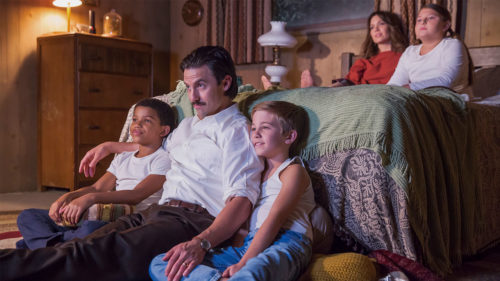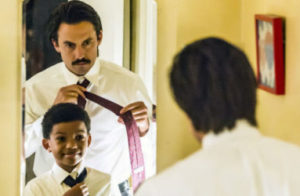
“This is Us” – NBC’s latest breakout series – tells one of the most poignant and intimate adoption stories to hit televisions yet. Exploring subjects like transracial adoption, closed adoption, and the effects of adoption on children, the show depicts the adoption journey with an undeniable realness, reflecting the emotional trials and experiences of adopted children, adoptive parents, and birth parents alike.
Now less than a month away, many of us are looking forward to the newest season of “This is Us,” which is scheduled to premiere late September. Many of us anticipate answers to questions like, “What happened to Jack?” and “Will Randall and his wife adopt a child?”. Before we get there, let us take a minute to reflect on Season 1.
Among the many storylines in the show “This is Us,” perhaps the most prominent is the story of Randall Pearson, a black child who is adopted by a white family in the 1980s. Flashing between the 80s and present day, Randall’s story teaches viewers that adoption is both a positive and complicated choice. As an adoption agency founded in the 1980s, Adoptions With Love knows the adoptions of this time well. To help educate others on adoption (then and now), we have outlined our top three takeaways from the “This is Us” adoption story.
1. Closed adoption can have negative effects.
In the show “This is Us,” Randall’s story begins with what is called a “safe haven” adoption – his birth father, William, leaves him in a basket on the doorstep of the local fire station. Randall’s mother had died giving birth and William, addicted to drugs at the time, was not ready to parent a newborn on his own. The firefighters brought Randall to the hospital, where fate then brought him and the Pearson family together. Randall was adopted by Jack and Rebecca Pearson, who had just lost their third triplet during birth.
The day Randall is adopted, William goes to the hospital discreetly to ensure that his baby is in good hands. Rebecca catches eyes with him, realizes who he is, and visits him later on in Randall’s childhood. But she chooses to keep this meeting, as well as her knowledge of Randall’s birth father, a secret. She does not tell her husband, Jack, and she does not tell Randall even though he asks. In efforts to protect both her son and her bond with her son, she tells William that he cannot have any contact with Randall.

The unknowns are hard on Randall. He grows up with no knowledge of his birth family and no official ties to his background or heritage. He grows up in a white household, with two siblings who both know and are raised by their biological parents. He tries to imagine what his birth parents look like and do, constantly confronting issues of identity and belonging. Despite belonging to a loving and supportive family, Randall is still deeply affected by what he does not know. He does not have any African American role models in his life.
Randall has what is called a closed adoption, in which he and his parents do not have ongoing contact with his birth family. He does not have access to answers about his background or adoption story. He does not grow up with respect or understanding of his birth mother and father. With little information about his roots and his African American heritage, he carries some confusion and hurt. These complicated feelings are reflected when he finally meets his birth father as an adult, after hiring a private investigator to seek William out.
Closed adoptions were more common in the 1980s, when the early “This is Us” storyline takes place. Back then, birth parents could not always choose a family for their baby. Adoptive families had limited knowledge of their child’s birth parents. Adopted children could not easily contact their birth families, and rarely met them in person.
Closed adoptions may seem like the best choice for adoptive parents like Rebecca, who are scared of the birth family and worry about how a birth family might affect their child. However, “This is Us” teaches us that secretive, closed adoptions can actually affect their child negatively, distilling feelings of confusion, anger, and guilt at a young age. The show also teaches us that having a connection to one’s birth family can create very positive, meaningful relationships – not negative ones.
That is why today, open adoption plans are more of the norm. Adoptive families can keep in touch with the child’s birth parents online, over the phone, through letters, through the adoption agency, and even in-person. From an early age, adopted children in open adoptions can grow up knowing who their birth parents are, what they look like, and why they chose adoption. This gives them greater confidence, greater respect, and greater understanding of themselves as they mature.
2. Adopted children are naturally curious about their roots, even if they do not ask.
Children are naturally curious. Even in the instance they have everything they could need or ask for, they still wonder about the whys, what ifs, and what could be. This is especially true for those children who have been adopted, those who do not always have complete clarity of their background or biology.
This curiosity, this inherent drive, to uncover one’s biological roots is depicted near perfectly in the series “This is Us.” Growing up, Randall has a stable and healthy home, a great education, as well as two married parents who love him unconditionally. Despite all of it, however, he still feels a void. He desires to know more about his birth parents. At one point in his childhood, he even walks around the grocery store asking black adults if they can roll their tongues as he can. He believes this genetic trait will help him track down his biological family.
Randall’s mother, Rebecca, takes this act personally. She worries she is not enough for Randall, and that finding his birth family could mean losing her son. Having a transracial adoption, she is especially insecure about her bond with Randall and whether she can meet all of his needs. Randall recognizes this and eventually keeps his questions to himself. He tries to hide any desire to know more about his roots, so as not to offend his parents.
The desire to know and understand more – about birth parents, about biological siblings, about traits that they all might share – is completely normal and necessary for adopted children. It is especially important for adoptive parents to recognize this, and to know that it is not a rejection or reflection of their parenting. This desire, this need, is a natural curiosity among adopted children to learn more about who they are. It is essential to developing their own sense of identity.
3. Birth parents are emotionally affected by adoption, too.

Adoption is a difficult journey, and we see that through Randall’s emotional struggles on “This is Us.” It is worthy to note, however, that Randall is not the only one who experiences complicated emotions throughout this journey. William, his birth father, also feels the heartbreak and overwhelming, yet delicate love that so often comes with adoption re-connections. For 36 years, William felt heartbreak, grief, and loss. Like Randall, William spent years of his life wondering “what if” and “what could be.” We see these feelings in several episodes of “This is Us.”
Adoption is a decision made with love; a decision made in the best interest of the child. What William chose to do that day, having a history of drug abuse, was in the best interest of Randall. Randall was able to grow up with two loving and devoted parents, in a safe neighborhood with opportunity to grow and thrive. Despite the loss that William felt after leaving his baby, he knew that he could not offer all of that to a child. So, he made a sacrifice.
Adoption is a lifelong journey that constantly shifts and turns, presenting new feelings and challenges at each phase and for each member of the adoption triad. Adoption can also be a beautiful journey full of understanding, forgiveness, and love. Randall’s adoption story in “This is Us” is an excellent example of the highs and lows, the happiness and hardships, that the adoption journey can bring to all who are touched by it.
What do you – as a birth parent, adoptive parent, or adoptee – think of the “This is Us” adoption story?